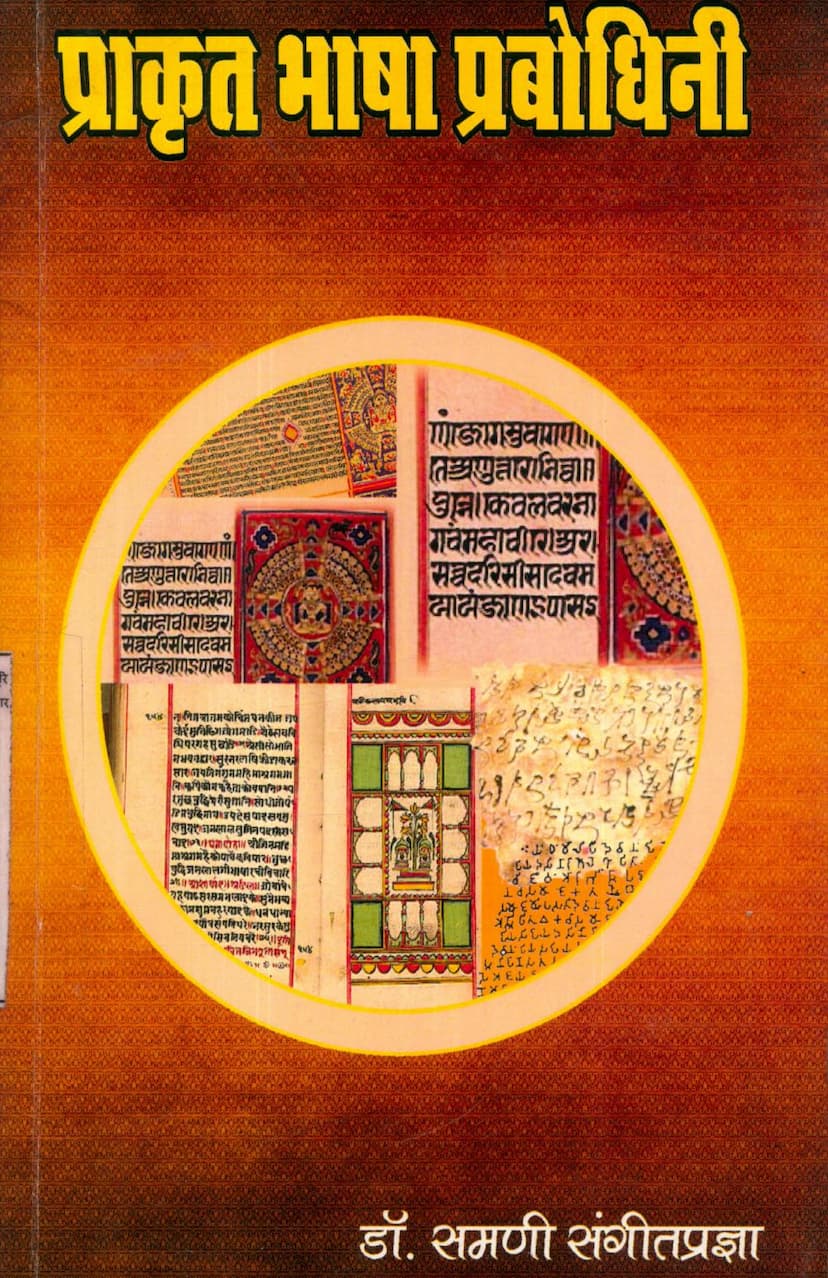Prakrit Bhasha Prabodhini
Added to library: September 2, 2025

Summary
Here's a comprehensive summary of the Jain text "Prakrit Bhasha Prabodhini" by Dr. Samani Sangeetprajna, based on the provided content:
Book Title: Prakrit Bhasha Prabodhini (प्राकृत भाषा प्रबोधिनी) Author: Dr. Samani Sangeetprajna Publisher: Jain Vishva Bharati Institute (मान्य विश्वविद्यालय), Ladnun
Overall Purpose: "Prakrit Bhasha Prabodhini" is an introductory guide designed to teach the Prakrit language. It aims to provide readers with a foundational understanding of Prakrit grammar, vocabulary, and its historical and literary significance. The book emphasizes practical application, enabling readers to learn to speak and write Prakrit through examples and exercises.
Key Themes and Content:
-
Introduction to Prakrit:
- Origin and Development: The book places Prakrit within the context of Indo-Aryan languages, tracing its development through three periods of Indian Aryan languages: Ancient (1600 BCE - 600 BCE), Medieval (600 BCE - 1000 CE), and Modern (1000 CE - present). It highlights the close relationship between Prakrit and Vedic Sanskrit, suggesting a common ancestral spoken language.
- Nature of Prakrit: Prakrit is described as a "Janbhasha" (folk language) that evolved into a literary language. It is characterized by its sweetness, poetic beauty, and flexibility, which allowed it to be embraced by various genres like Agamas, commentaries, stories, epics, and even inscriptions.
- Cultural Significance: Prakrit is presented as a significant vehicle of Indian culture, influencing thought, ethics, and the literary world. Its openness to adopting elements from diverse languages made it universal and accessible.
-
Stages and Forms of Prakrit:
- Early Prakrit (Pre-Mahavira to Mahavira era): The spoken Prakrit of this period is referred to as "First-level Prakrit."
- Second-level Prakrit (Mahavira era to 2nd century CE): This includes Prakrit found in Agamas, inscriptions, and dramas.
- Third-level Prakrit (3rd to 6th/7th century CE): Prakrit used in literature during this time.
- Key Prakrit Dialects: The book details several important Prakrit dialects:
- Magadhi: The language of the Magadha region, influential in the development of Pali and Ardhamagadhi.
- Ardhamagadhi: Spoken between Western Shurasena and Eastern Magadha, likely incorporating features of both. It is dated to the 4th century BCE.
- Shauraseni: The spoken language of the Shurasena region (Mathura), used in Ashoka's inscriptions and dramas. It had a broader usage in the central region.
- Other Forms of Prakrit:
- Epigraphical Prakrit: Found in Ashoka's edicts and later inscriptions, demonstrating its prevalence in public life.
- Niya Prakrit: Found in scripts from Chinese Turkestan, showing similarities and connections with Daradi languages.
- Prakrit Dharmapada: A separate Dharmapada written in Prakrit, distinct from the Pali version.
- Prakrit in Ashvaghosha's Dramas: Represents the Prakrit of the early period, exhibiting features of various Prakrits.
-
Medieval Period Prakrit (2nd to 6th Century CE):
- This era is considered a rich period for Prakrit language and literature.
- Maharashtri Prakrit: Developed from the spoken language of the Maharashtra region, it became the dominant literary Prakrit due to its soft and sweet sounds, widely used in poetry.
- Magadhi: Continued its influence and served as a basis for other Prakrits.
- Paishachi: Associated with the northwestern regions and known for the lost "Brihatkatha."
- Standardization: The increasing use of Prakrit in literature led to a trend towards standardization, primarily in Maharashtri, which contributed to its literary stability but also slightly distanced it from common folk speech, leading to the development of Apabhramsha.
-
Apabhramsha (Post-Prakrit/Early Modern Period):
- Considered the third stage of Prakrit's development, Apabhramsha bridges Prakrit and modern Indian languages. It is characterized by further simplification of grammar and vocabulary.
-
Prakrit Grammar:
- Introduction to Grammar: The book explains the concept, purpose, and importance of grammar, defining it as the science that regulates language elements. It highlights the goals of grammar: correctness, clarity, and understanding.
- Key Prakrit Grammatical Works: A historical overview of significant Prakrit grammars is provided, including:
- Prakrit Lakshana by Chand (earliest)
- Prakrit Prakash by Vararuci
- Prakrit Shabdanushasana by Purushottamdeva
- Siddha-Hema Shabdanushasana by Hemachandra (considered definitive)
- Prakrit Shabdanushasana by Trivikrama
- And many others, emphasizing the rich tradition of Prakrit grammatical study.
- General Prakrit Rules: The book outlines fundamental rules:
- Nature of Prakrit: Generally following Sanskrit in terms of roots, suffixes, gender, case, etc., with some modifications.
- Vowels: Lists the eight Prakrit vowels (a, aa, i, ii, u, uu, e, o) and discusses their changes (hastva and dirgha). It notes the absence of 'ai' and 'au' but occasional occurrences.
- Consonants: Details the Prakrit consonants and their changes, including changes to initial, medial, and final consonants, and modifications in consonant clusters.
- Sandhi (euphony): Explains the rules of vowel and consonant sandhi, noting that they are often optional in Prakrit compared to Sanskrit.
- Declension and Conjugation: Extensive sections are dedicated to Prakrit declension (word forms for nouns, pronouns, and adjectives) and conjugation (verb forms in present, past, and future tenses, imperatives, subjunctives). It covers various noun declensions (masculine, feminine, neuter, ending in different vowels and consonants) and verb conjugations with examples.
- Vocabulary: The book includes lists of common adverbs (avyaya) and prepositions/prefixes (upasarga), along with their origins and meanings.
- Sentence Construction: Provides examples of sentence structures using various cases (vibhaktis) and verb conjugations.
-
Author's Acknowledgment:
- Dr. Samani Sangeetprajna expresses gratitude to Acharya Shri Mahashramanji and Sadhvi Pramukhshri for their inspiration. She also thanks Sadhvi Mangalprajna for her guidance, current Vice-Chancellor Samani Charitrapragna for her permission, and esteemed professors from Jain Vishva Bharati Institute for their scholarly contributions.
Target Audience: The book is intended for students, scholars, and anyone interested in learning the Prakrit language and its cultural heritage. It aims to make the study of Prakrit accessible and practical.
In essence, "Prakrit Bhasha Prabodhini" is a comprehensive pedagogical work that systematically introduces the Prakrit language, covering its historical evolution, literary expressions, grammatical intricacies, and practical usage through a wealth of examples.